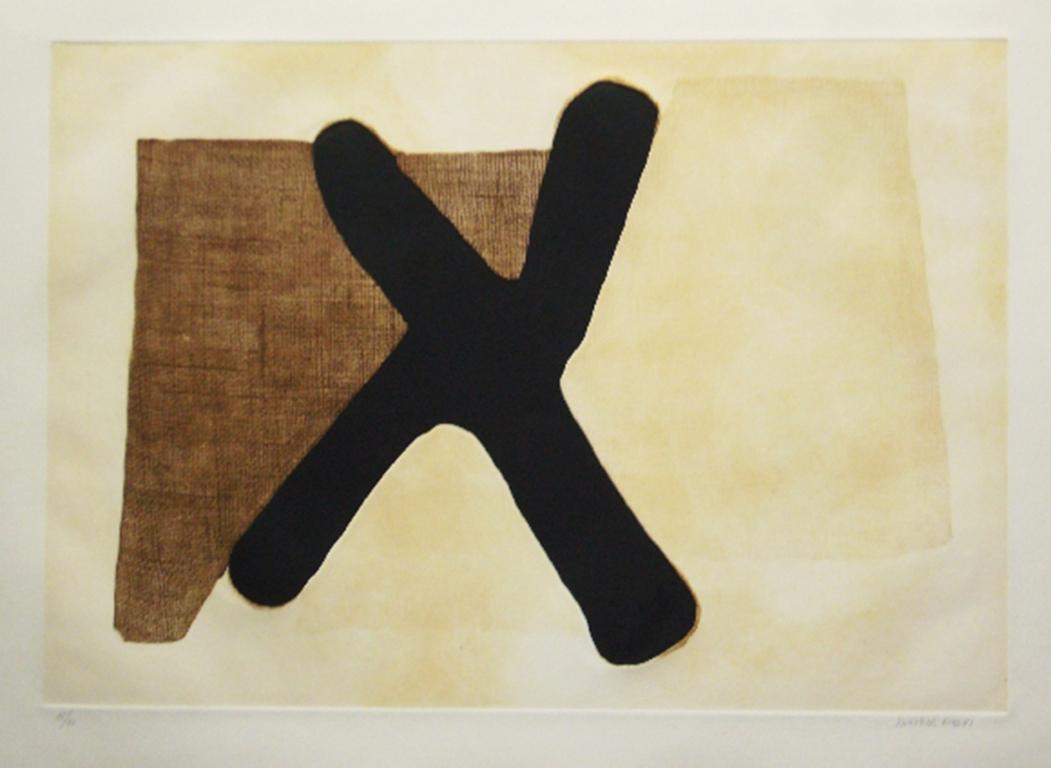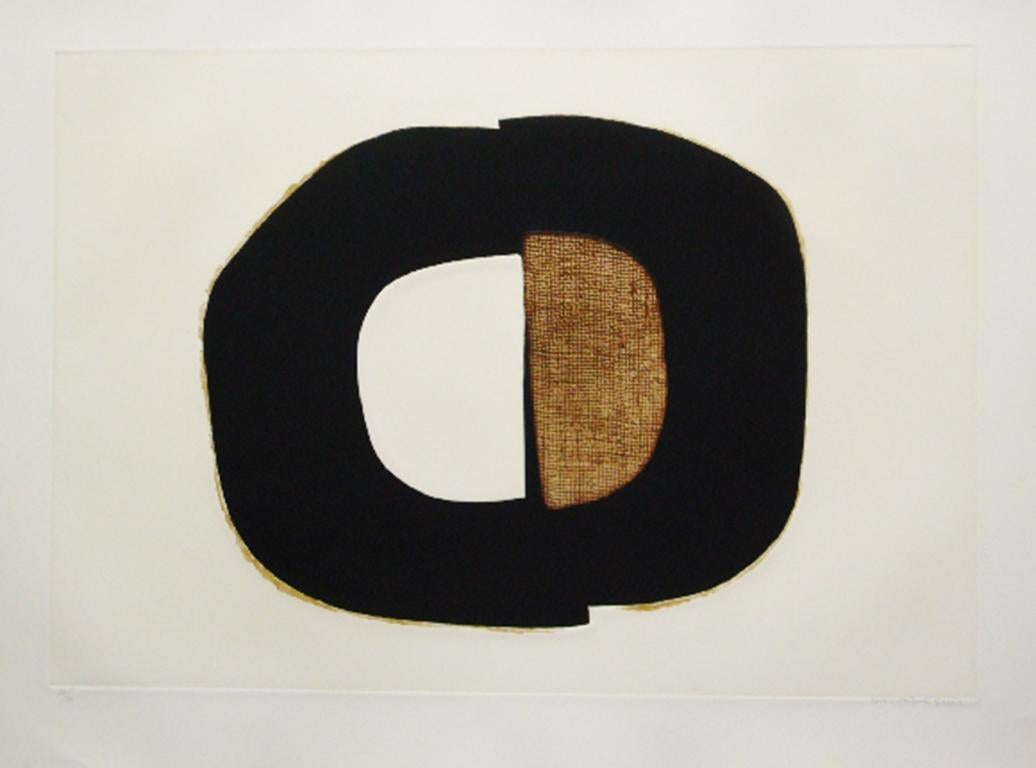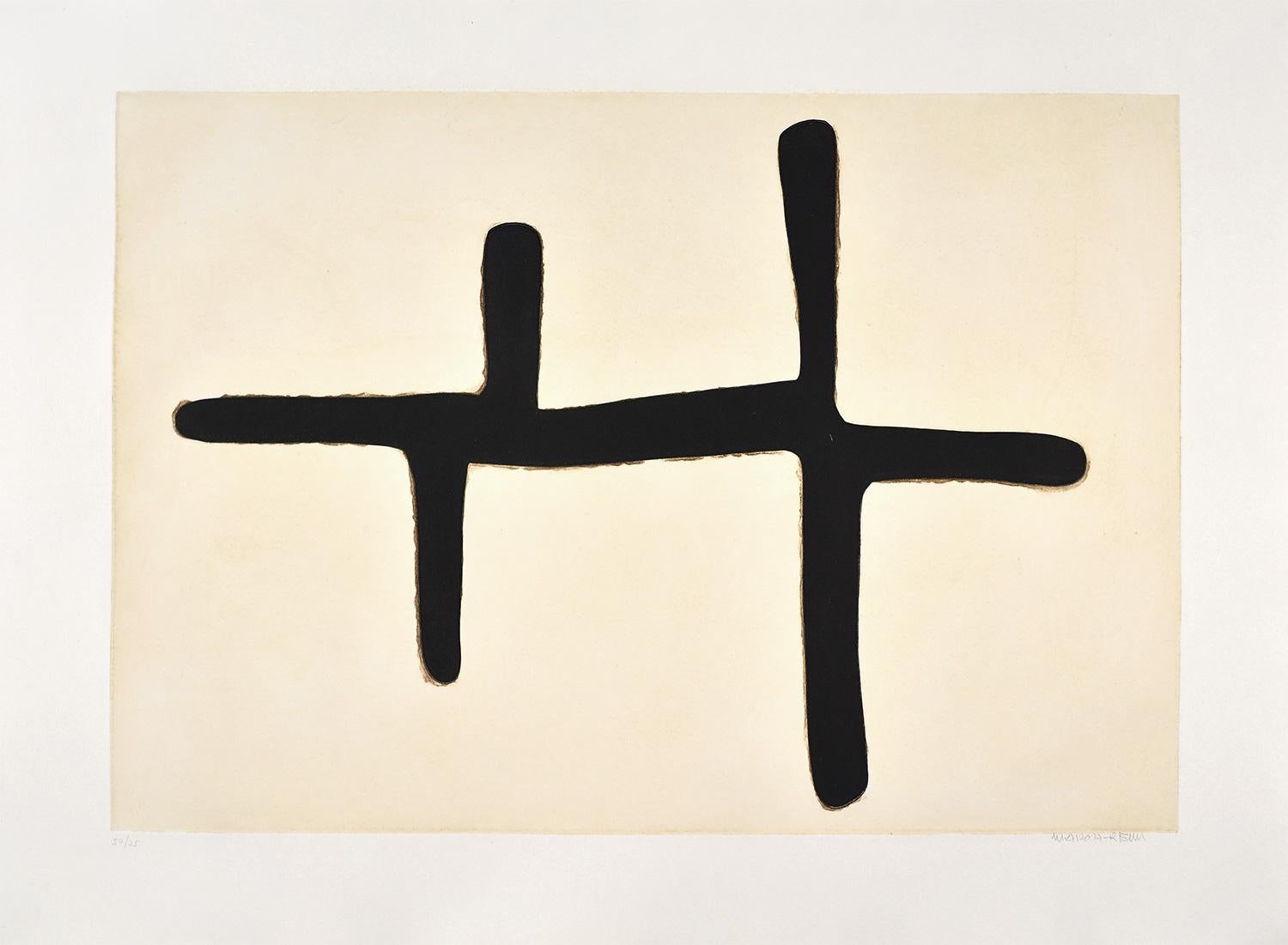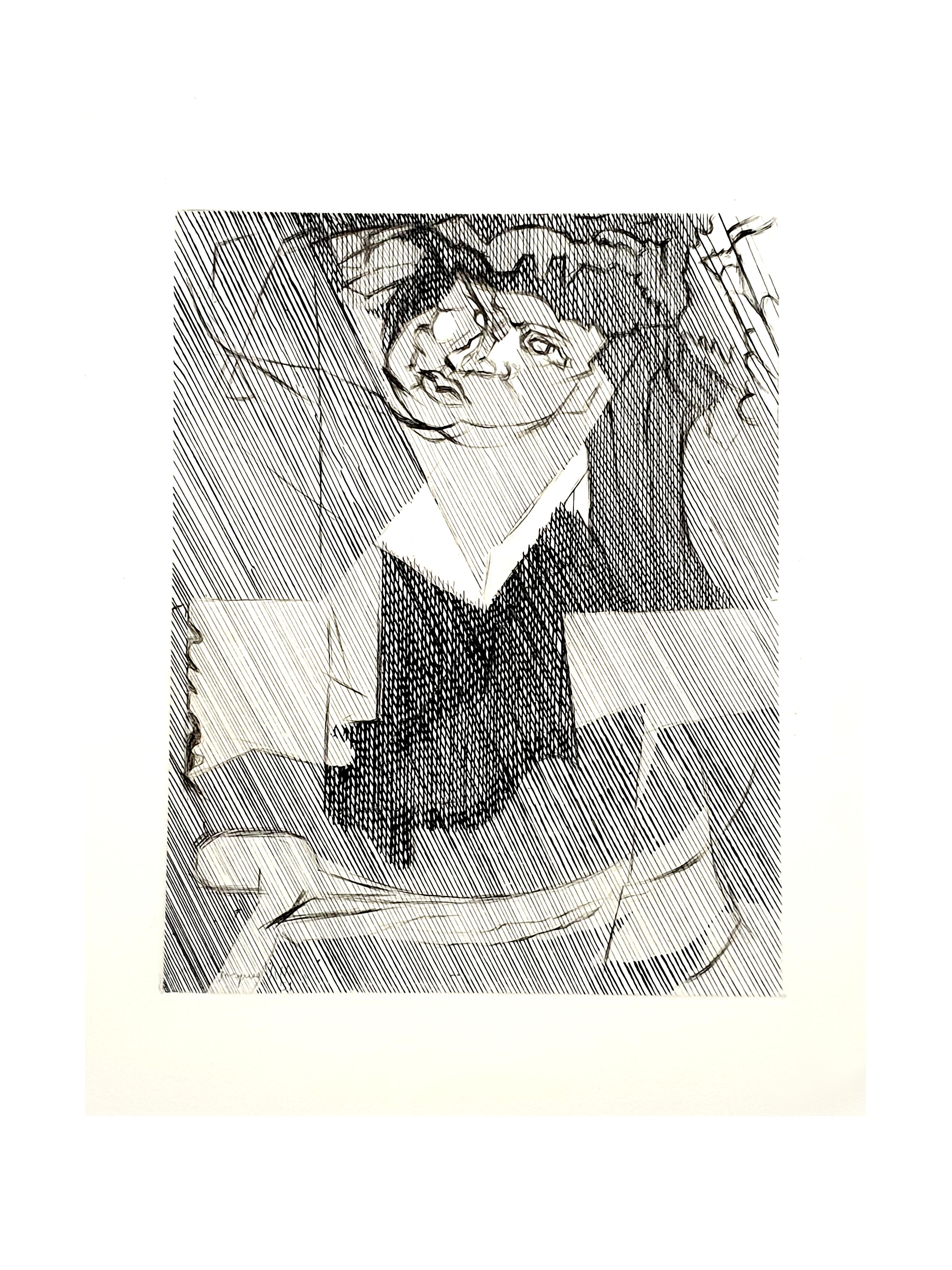Items Similar to 'Expansion' — Modernist Abstraction, Atelier 17
Want more images or videos?
Request additional images or videos from the seller
1 of 7
Stanley William Hayter'Expansion' — Modernist Abstraction, Atelier 171970
1970
About the Item
Stanley William Hayter, 'Expansion', color etching and soft-ground, 1970, edition 100, Black & Moorhead 334. Signed, titled, dated, and numbered '23/50' in pencil. A superb, richly inked impression with fresh, vivid colors on heavy off-white wove paper; the full sheet with margins (2 to 2 1/2 inches), in excellent condition. Matted to museum standards, unframed.
Image size 17 1/8 x 19 7/16 inches (435 x 494 mm); sheet size 22 x 23 1/2 inches (559 x 597 mm).
This image was created in the first state using a plate covered with a plastic sheet; the sheet was cut, and the soft-ground texture was added. In the second state, the plate was covered again, and the sheet cut then etched with a deep bite, and a soft ground texture was added. Printed by Hector Saunier: intaglio fluorescent orange, hard roller phthalo green, soft roller transparent yellow.
Note: the online image does cannot accurately convey the vibrancy of the printed fluorescent orange.
ABOUT THE ARTIST
Stanley William Hayter (1901-1988) was a British painter and printmaker associated in the 1930s with Surrealism and from 1940 onward with Abstract Expressionism. Regarded as one of the most significant printmakers of the 20th century, Hayter founded the legendary Atelier 17 studio in Paris, now known as Atelier Contrepoint. Among the artists he is credited with influencing are Pablo Picasso, Alberto Giacometti, Joan Miró, Alexander Calder, and Marc Chagall.
The hallmark of the workshop was its egalitarian structure, breaking sharply with the traditional French engraving studios by insisting on a cooperative approach to labor and technical discoveries. In 1929 Hayter was introduced to Surrealism by Yves Tanguy and André Masson, who, with other Surrealists, worked with Hayter at Atelier 17. The often violent imagery of Hayter’s Surrealist period was stimulated in part by his passionate response to the Spanish Civil War and the rise of Fascism. He organized portfolios of graphic works to raise funds for the Spanish cause, including Solidarité (Paris, 1938), a portfolio of seven prints, one of them by Picasso. Hayter frequently exhibited with the Surrealists during the 1930s but left the movement when Paul Eluard was expelled. Eluard’s poem Facile Proie (1939) was written in response to a set of Hayter’s engravings. Other writers with whom Hayter collaborated in this way included Samuel Beckett and Georges Hugnet.
Hayter joined the exile of the Parisian avant-garde in 1939, moving with his second wife, the American sculptor Helen Phillips, to New York. He ran a course entitled ‘Atelier 17’ at the New School for Social Research until 1945 when he opened the workshop independently in Greenwich Village at 41 East 8th Street. Important figures in the emerging New York School associated with Hayter included Jackson Pollock, Robert Motherwell, Willem de Kooning, Mark Rothko, William Baziotes, and David Smith.
By 1946 Atelier 17 was operating independently in expanded and more versatile facilities. Engagements and temporary appointments kept Hayter traveling all over the country. In 1949 he published 'New Ways of Gravure', a book that included a short history of intaglio techniques and a description of the experiments and achievements of Atelier 17. In 1950 Hayter returned to Europe and reestablished Atelier 17 in Paris. Without him, the New York shop began a steady decline until its closing in 1955, whereas in Paris, the studio flourished.
Throughout the 1980s, Hayter continued to work with his customary drive and openness, consistently responding to currents of style and technique, eventually gravitating back to painting. In 1987, with the purchase of four hundred prints ranging in date from 1926 through 1960, the British Museum became the largest repository of Hayter’s work. When the artist died in London on May 4, 1988, work was underway on a major retrospective of his prints at the Ashmolean Museum at Oxford.
Hayter's graphic work is today included in almost every major 20th-century printmaking museum collection throughout the United States, the UK, and Europe, including The Art Institute of Chicago, Bibliothèque nationale de France (Paris), British Museum, Centre Pompidou (Paris), Harvard Art Museum, Hunterian Museum (University of Glasgow), Hyogo Prefectural Museum of Art (Kobe, Japan), Guggenheim Museum, Los Angeles County Museum of Art, Metropolitan Museum of Art, Museum of Fine Arts Boston, Museum of Modern Art, Musée d’Art Moderne de la Ville, (Paris), National Gallery of Art, Peggy Guggenheim Museum (Venice), Philadelphia Museum of Art, Royal Academy of Art (London), San Francisco Museum of Modern Art, Smithsonian American Art Museum, Tate Modern (London), Victoria & Albert Museum (London), Whitney Museum of American Art, Yale University Art Gallery.
- Creator:Stanley William Hayter (1901-1988, British)
- Creation Year:1970
- Dimensions:Height: 17.13 in (43.52 cm)Width: 19.44 in (49.38 cm)
- Medium:
- Movement & Style:
- Period:
- Condition:
- Gallery Location:Myrtle Beach, SC
- Reference Number:
About the Seller
5.0
Recognized Seller
These prestigious sellers are industry leaders and represent the highest echelon for item quality and design.
Platinum Seller
These expertly vetted sellers are 1stDibs' most experienced sellers and are rated highest by our customers.
Established in 1995
1stDibs seller since 2016
254 sales on 1stDibs
Typical response time: 2 hours
Associations
International Fine Print Dealers Association
- ShippingRetrieving quote...Ships From: Myrtle Beach, SC
- Return PolicyA return for this item may be initiated within 7 days of delivery.
More From This SellerView All
- 'Danse du Soleil' (Sun Dance; Sun Dancer) — Mid-century Modernism, Atelier 17By Stanley William HayterLocated in Myrtle Beach, SCStanley William Hayter, 'Danse du Soleil (Danseuse du Soleil; Sun Dance; Sun Dancer)', color engraving, soft-ground etching and scorper; 1 of 10 artist's proofs, edition 200, 1951, Black & Moorhead 197. Signed and annotated 'Epreuve d’Artiste II/XII' in pencil. Inscribed 'Pour Nesto Jacometti avec amitié' in pencil, in the artist’s hand. A superb, richly-inked impression, with fresh colors, on handmade Arches cream wove paper; full margins (2 3/4 to 4 inches), in excellent condition. Image size 15 7/16 x 9 7/16 inches; sheet size 22 1/4 x 15 inches. Matted to museum standards, unframed. Printed by Hayter and Atelier 17. Published by La Guilde Internationale de la Gravure, Geneva. Impressions of this work are in the permanent collections of the British Museum and the Yale University Art Gallery. ABOUT THE ARTIST Stanley William Hayter (1901-1988) was a British painter and printmaker associated in the 1930s with Surrealism and from 1940 onward with Abstract Expressionism. Regarded as one of the most significant printmakers of the 20th century, Hayter founded the legendary Atelier 17 studio in Paris, now known as Atelier Contrepoint. Among the artists he is credited with influencing are Pablo Picasso, Alberto Giacometti, Joan Miró, Alexander Calder, and Marc Chagall. The hallmark of the workshop was its egalitarian structure, breaking sharply with the traditional French engraving studios by insisting on a cooperative approach to labor and technical discoveries. In 1929 Hayter was introduced to Surrealism by Yves Tanguy and André Masson, who, with other Surrealists, worked with Hayter at Atelier 17. The often violent imagery of Hayter’s Surrealist period was stimulated in part by his passionate response to the Spanish Civil War and the rise of Fascism. He organized portfolios of graphic works to raise funds for the Spanish cause, including Solidarité (Paris, 1938), a portfolio of seven prints, one of them by Picasso. Hayter frequently exhibited with the Surrealists during the 1930s but left the movement when Paul Eluard was expelled. Eluard’s poem Facile Proie (1939) was written in response to a set of Hayter’s engravings. Other writers with whom Hayter collaborated included Samuel Beckett and Georges Hugnet. Hayter joined the exile of the Parisian avant-garde in 1939, moving with his second wife, the American sculptor Helen Phillips...Category
1950s American Modern Abstract Prints
MaterialsEngraving, Etching
- QuintetBy Terry HaassLocated in Myrtle Beach, SC'Quintet', etching and aquatint, edition 20, c. 1948. Signed, titled, and numbered '12/20' in pencil. A superb, richly-inked impression, on off-white wove paper, with full margins (1...Category
1940s Modern Abstract Prints
MaterialsEtching, Aquatint
- 'Feu sous L'eau' (Fire Under Water) —Mid-century Modernism, Atelier 17By Stanley William HayterLocated in Myrtle Beach, SCStanley William Hayter, 'Feu sous L'eau (Fire Under Water)', color engraving, soft-ground etching and scorper with yellow silkscreen, 1955, edition 50 plus 10 artist proofs, Black & Moorhead 221. Signed, titled 'Fire Under Water', dated and annotated 'Essai' in pencil. Dedicated in the artist’s hand 'for Adja & Dove WH Bill 17–5–55' in the top margin. A superb, richly inked impression with fresh colors, on heavy, cream wove paper; wide margins (2 1/2 to 3 7/8 inches), in excellent condition. One of 10 artist’s proofs. Image size 10 3/16 x 7 inches; sheet size 18 1/8 x 12 1/4 inches. Matted to museum standards, unframed. ABOUT THIS WORK In 1950 Hayter returned to Paris and reopened Atelier 17. Works such as 'Fire Under Water' reveal newfound influences, such as that of the Ardèche area of southern France, where he acquired a house in 1951 and frequently visited. Hayter took great interest in the flowing Escoutay River, an experience that parallels the artist and co-director of Atelier 17 Krishna Reddy’s interest in depicting water. While some forms in this print evoke the natural world, the palette of contrasting tones of purple, yellow, black, and white reflects Hayter’s belief in using color intuitively to express emotions and evoke feelings. The sharp white relief lines from the paper and the textural effects realized through soft-ground etching operate in tandem with the sweeping curves and bold colors to give the composition a sense of vitality and dynamism. —edited from the Metropolitan Museum of Art Published by 'La Jeune Gravure Contemporaine', Paris. Impressions of this work are in the following collections: British Museum, Metropolitan Museum of Art, National Gallery of Art. ABOUT THE ARTIST Stanley William Hayter (1901-1988) was a British painter and printmaker associated in the 1930s with Surrealism and from 1940 onward with Abstract Expressionism. Regarded as one of the most significant printmakers of the 20th century, Hayter founded the legendary Atelier 17 studio in Paris, now known as Atelier Contrepoint. Among the artists he is credited with influencing are Pablo Picasso, Alberto Giacometti, Joan Miró, Alexander Calder, and Marc Chagall. The hallmark of the workshop was its egalitarian structure, breaking sharply with the traditional French engraving studios by insisting on a cooperative approach to labor and technical discoveries. In 1929 Hayter was introduced to Surrealism by Yves Tanguy and André Masson, who, with other Surrealists, worked with Hayter at Atelier 17. The often violent imagery of Hayter’s Surrealist period was stimulated in part by his passionate response to the Spanish Civil War and the rise of Fascism. He organized portfolios of graphic works to raise funds for the Spanish cause, including Solidarité (Paris, 1938), a portfolio of seven prints, one of them by Picasso. Hayter frequently exhibited with the Surrealists during the 1930s but left the movement when Paul Eluard was expelled. Eluard’s poem Facile Proie (1939) was written in response to a set of Hayter’s engravings. Other writers with whom Hayter collaborated included Samuel Beckett and Georges Hugnet. Hayter joined the exile of the Parisian avant-garde in 1939, moving with his second wife, the American sculptor Helen Phillips...Category
1950s Abstract Expressionist Abstract Prints
MaterialsEngraving, Etching
- 'Green Shade' — Mid-century Modernism, Abstract Expressionism, Atelier 17By Stanley William HayterLocated in Myrtle Beach, SCStanley William Hayter, 'Green Shade', color etching and scraper, 1963, edition 50, (only 39 printed), B&M 278. Signed, titled, dated, and numbered '1/50' in pencil. A superb, richly-inked, luminous impression, with fresh, vivid colors, on Barcham Green textured cream wove paper; the full sheet with margins (2 3/16 to 3 1/4 inches), in excellent condition. Printed: intaglio black-green, contact lumogen yellow, soft roller phthalo green. Scarce. Image size 15 7/16 x 11 5/8 inches (392 x 295 mm); sheet size 21 1/8 x 16 inches (537 x 406 mm). Matted to museum standards (unframed). Collection: The British Museum ABOUT THE ARTIST Stanley William Hayter (1901-1988) was a British painter and printmaker associated in the 1930s with Surrealism and from 1940 onward with Abstract Expressionism. Regarded as one of the most significant printmakers of the 20th century, Hayter founded the legendary Atelier 17...Category
1960s Abstract Expressionist Abstract Prints
MaterialsEtching
- 'Flight to Tomorrow' — Mid-Century American Modernism — Atelier 17By Minna CitronLocated in Myrtle Beach, SCMinna Citron, 'Flight to Tomorrow', aquatint and engraving, edition unknown but small, 1948. Signed, titled, dated, and annotated 'engr & aqua' in pencil. A superb, richly-inked impression with selectively wiped plate tone, on heavy cream wove paper, the full sheet with margins (1 3/4 to 3 1/2 inches), in excellent condition. Image size 6 7/8 x 8 7/16 inches (175 x 214 mm); sheet size 11 1/8 x 14 7/8 inches (283 x 378 mm). Matted to museum standards, unframed. Literature: The Women of Atelier 17, Modernist Printmaking in MidCentury New York, Christina Weyl, Yale University Press, 2019, p. 186. Collections: Davis Museum (Wellesley), Five Colleges and Historic Deerfield Museum Consortium, Harvard Art Museums, Museum of Fine Arts, Boston, Palmer Museum of Art (Penn State...Category
1940s Abstract Expressionist Abstract Prints
MaterialsEngraving, Aquatint
- Les Penitentes #3By Ralston CrawfordLocated in Myrtle Beach, SCRalston Crawford, 'Los Penitentes #3', etching, 1976, edition 20. Signed and numbered '6/20' in pencil; titled and annotated 'specially selected for Marcelle and Dan' in the bottom s...Category
1970s Abstract Abstract Prints
MaterialsEtching
You May Also Like
- CONRAD MARCA-RELLI Limited ed. Etching & Aquatint American Modern, ContemporaryBy Conrad Marca-Relli 1Located in Madrid, MadridConrad Marca Relli - Composition XIII Date of creation: 1977 Medium: Etching and aquatint on Gvarro paper Edition: 75 + AP + HC Size: 56 x 76 cm Condition: In very good conditions an...Category
1970s Modern Abstract Prints
MaterialsEtching, Aquatint
- CONRAD MARCA-RELLI Limited ed. Etching & Aquatint American Modern, ContemporaryBy Conrad Marca-Relli 1Located in Madrid, MadridConrad Marca Relli - Composition X Date of creation: 1977 Medium: Etching and aquatint on Gvarro paper Edition: 75 + AP + HC Size: 56 x 76 cm Condition: In very good conditions and n...Category
1970s Modern Abstract Prints
MaterialsEtching, Aquatint
- CONRAD MARCA-RELLI Limited ed. Etching & Aquatint American Modern, ContemporaryBy Conrad Marca-Relli 1Located in Madrid, MadridConrad Marca Relli - Composition VI Date of creation: 1977 Medium: Etching and aquatint on Gvarro paper Edition: 75 + AP + HC Size: 56 x 76 cm Condition: In very good conditions and ...Category
1970s Modern Abstract Prints
MaterialsEtching, Aquatint
- CONRAD MARCA-RELLI Limited ed. Etching & Aquatint American Modern, ContemporaryBy Conrad Marca-Relli 1Located in Madrid, MadridConrad Marca Relli - Composition V Date of creation: 1977 Medium: Etching and aquatint on Gvarro paper Edition: 75 + AP + HC Size: 56 x 76 cm Condition: In very good conditions and n...Category
1970s Modern Abstract Prints
MaterialsEtching, Aquatint
- Conrad Marca-Relli - Etching & Aquatint American Modern Abstract ExpressionismBy Conrad Marca-Relli 1Located in Madrid, MadridConrad Marca-Relli - Composition XI Date of creation: 1977 Medium: Etching and aquatint on Gvarro paper Edition number: H.C. Size: 56 x 76 cm Condition: In very good conditions and n...Category
1970s Modern Abstract Prints
MaterialsEtching, Aquatint
- Jacques Villon - Cubist Man - Original EtchingBy Jacques VillonLocated in Collonge Bellerive, Geneve, CHJacques Villon - Cubist Man - Original Etching From the literary review "XXe Siècle" 1951 Dimensions: 32 x 24 cm Publisher: G. di San Lazzaro. Unsigned and unumbered as issuedCategory
1950s Modern Abstract Prints
MaterialsEtching
Recently Viewed
View AllMore Ways To Browse
Firestone Vintage Tires
Vintage Techno
Niki Vintage
Hirst The Currency
Kawasaki Vintage
Sam Francis Poster
Vintage Jesus Art
Lisa Winick
Louis Comfort Tiffany Magnolia
Louis Vuitton Straw Hat
Louisa Chase On Sale
B Adams N Z
Bryan Illsley
Ed Ruscha Suds
Elijah Burritt
Elisabeth Kley
Eric Freeman Shift Blue
Frank Roth On Sale





